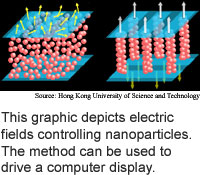
Nanoparticles drive display
Over the past decade researchers have moved
closer to the goal of electronic paper -- a computer screen that combines
the data manipulation abilities of computers with the high contrast and
physical flexibility of paper.
Researchers from the Hong Kong University of Science and Technology
in China and the Polytechnic School in France have advanced the field
with a technology that has the potential to provide inexpensive, low-power,
color electronic paper.
Like existing electronic paper schemes, the researchers' method
involves manipulating tiny particles dispersed in liquid. Existing schemes
move negatively charged black particles and positively charged white particles
to the back or front of a tiny chamber depending on the polarity of an
applied electric field. The new scheme, however, uses neutral rather than
charged particles.
The researchers' neutral particles gain electric charges -- negative
at one end and positive at the other -- in the presence of an electric
field. When this happens, the particles connect to each other like magnets,
forming chains between pairs of electrodes.
Particles floating in liquid allow light through, while particles
that have formed chains do not. The chains remain in place for several
hours after the electric field is switched off. Given a white background
and black particles, the display looks like paper.
The particles are made from barium titanium oxalato surrounded
by a urea shell, and average 50 nanometers in diameter. A nanometer is
one millionth of a millimeter.
The researchers' next steps are to modify the nanoparticles to
provide color and reduce the power needed to form chains.
The display could be ready for commercial use in five to ten years,
according to the researchers. The work appeared in the March 1, 2005 issue
of Nanotechnology (Neutral Nanoparticle-Based Display).
Stories:
Machine reproduces itself
Conference system makes shared space
Nanotube memory scheme is magnetic
How It Works: Robot navigation
Briefs:
Nanoparticles drive display
Thin silver sheet makes superlens
Catalyst boosts gasoline fuel cells
Virtual DNA makes material

Research Watch blog
View from the High Ground Q&A
How It Works
RSS Feeds:
News
Ad links:
Buy an ad link
Ad links: Clear History
Buy an ad link
|
TRN
Newswire and Headline Feeds for Web sites
|
© Copyright Technology Research News, LLC 2000-2010. All rights reserved.